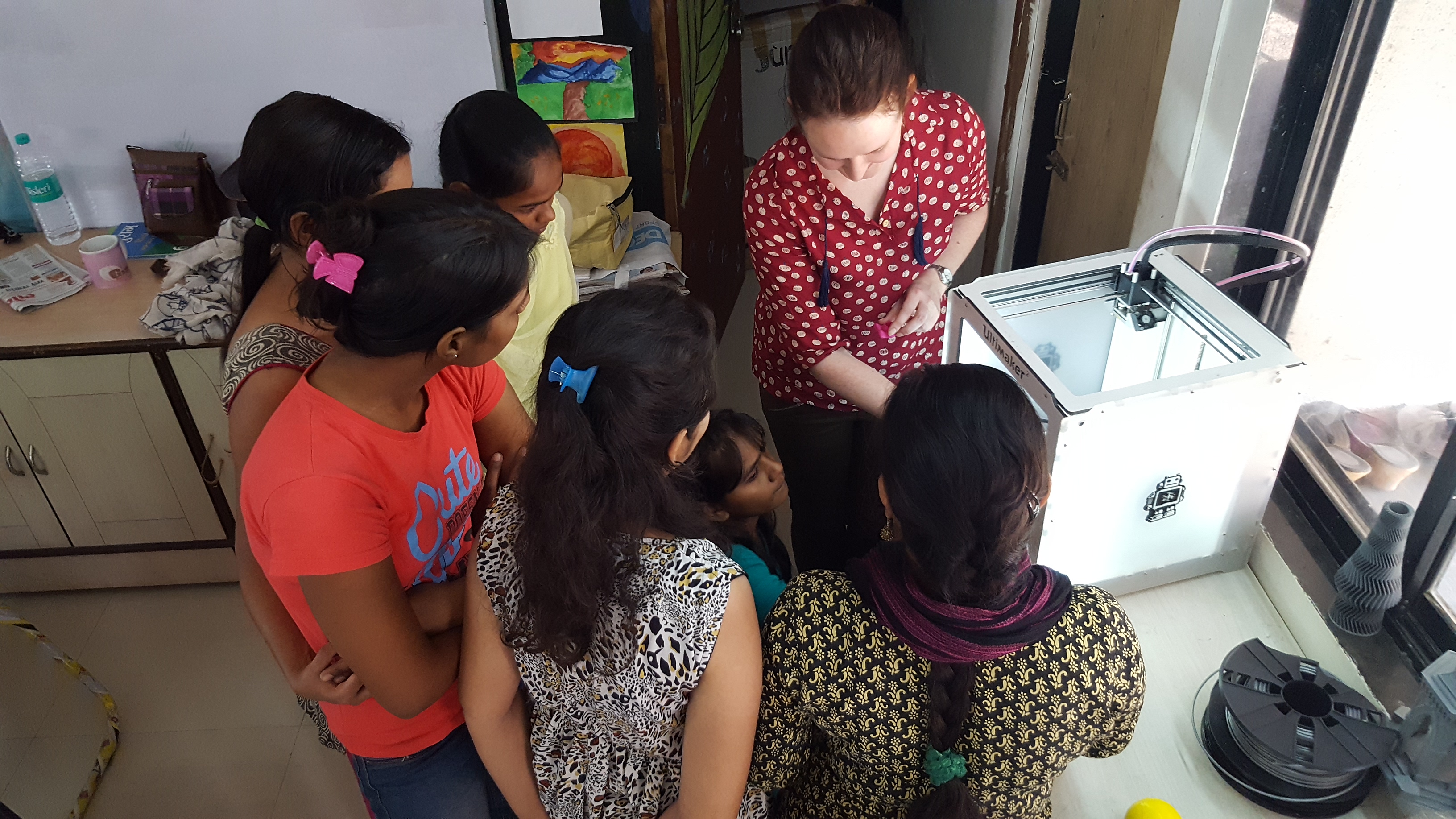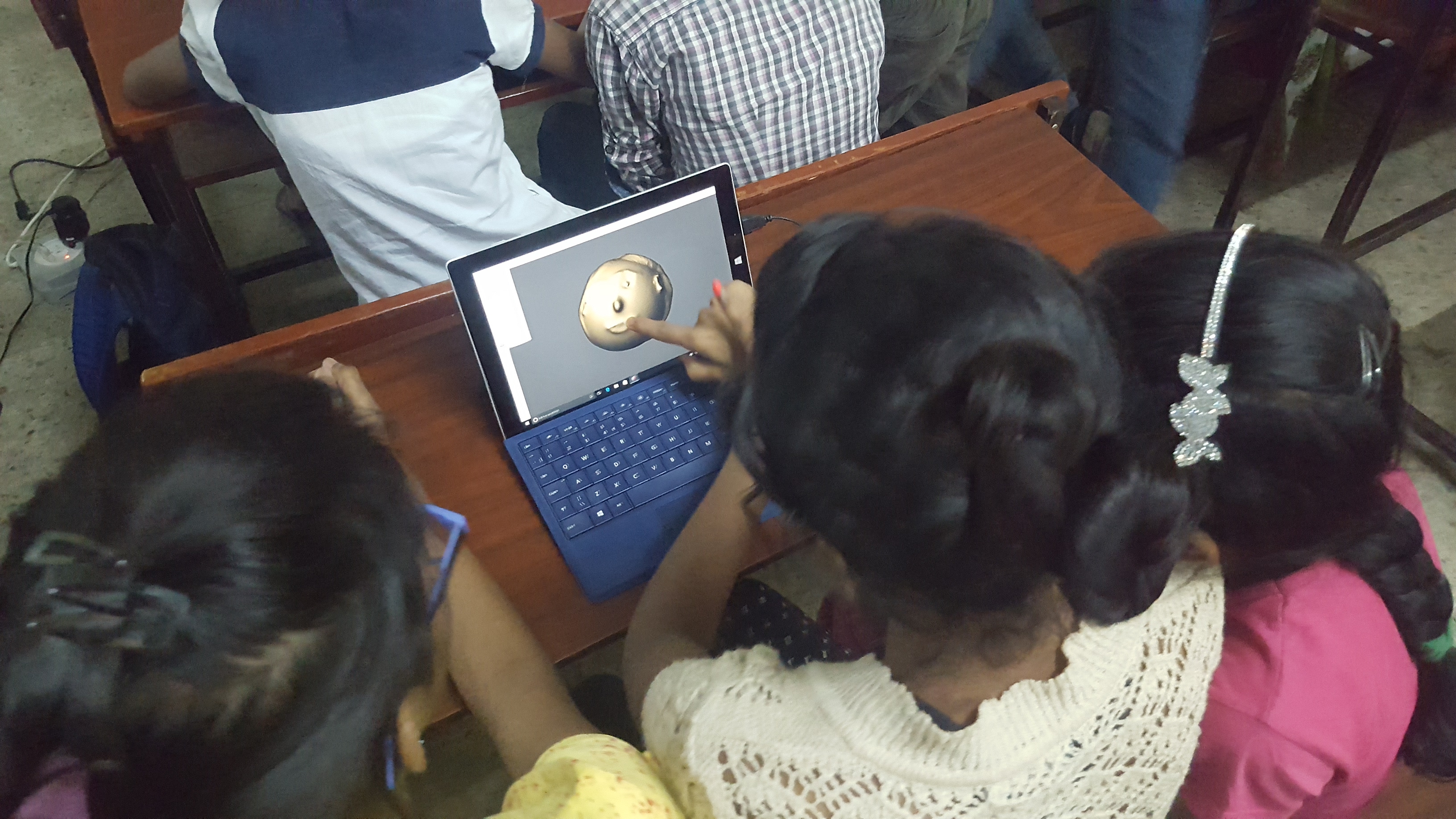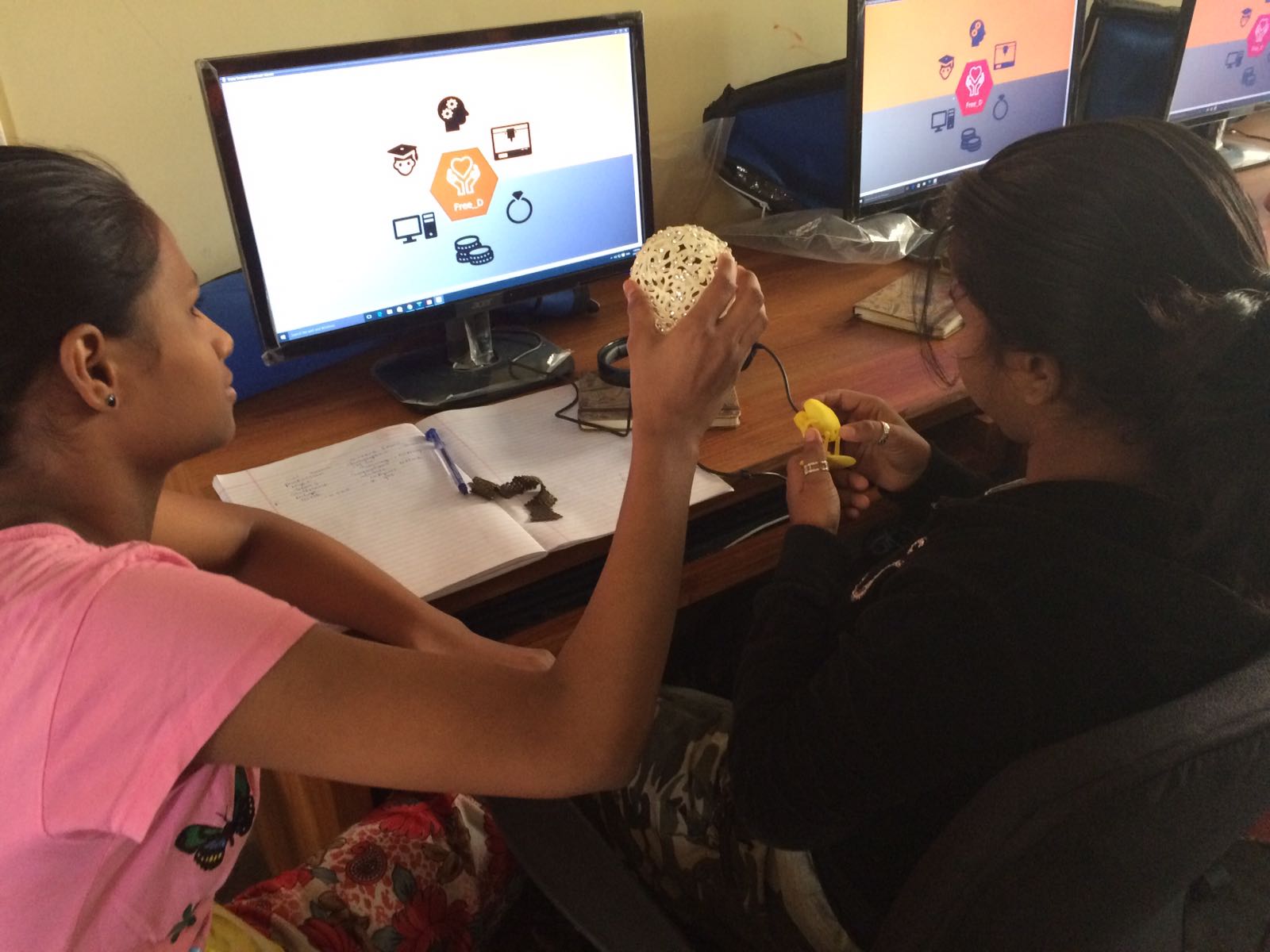3D printing in India: Additive Manufacturing for Women Empowerment with the Free_D project
Posted By Amandine Richardot on Sep 13, 2017 | 0 comments
3D printing is well-known for the many benefits it can bring regarding rapid prototyping or manufacturing products, either for industrial parts or consumer goods. To sum it up: additive manufacturing is making ideas come to life, almost without limits. But that’s not the only interesting thing with 3D printing. Indeed, this technology can be used for projects which aim to have a strong positive social impact. This week, we decided to showcase a great project which goes in this direction, called Free_D. This social enterprise aims to support and up-skill disadvantaged women in India, using 3D printing. Basically, they teach them how to do 3D modeling, how to use 3D printers, and how to run their own 3D printed jewelry business. To learn more about it, we had a chat with Katherine Prescott, CEO of Free_D.
3D printing in India: Introducing the Free_D project
First, can you introduce yourself to our readers?
The founders of Free_D have been working within the 3D printing space for over 15 years. My co-founder Dr. Sia Mahdavi designed and built his first 3D printed part back at university, where he received a BEng in Mechatronics, an MSc in Artificial Intelligence and went straight into a Ph.D. in Evolutionary Robotics.
After graduating, Siavash started Within, a company that used AI to generatively design complex forms that would then be 3D Printed. His software paved the way for a new generation of tools that would fully exploit the new-found design freedoms that Additive Manufacturing offered. Within made breakthroughs in the design of lightweight aircraft components, customised running shoes and even orthopedic implants.
Two years later, he co-founded his second start up, serving as its CTO, while continuing to run Within. Digital Forming was founded to spearhead mass customisation of consumer products. After raising seed investment from EOS, an Additive manufacturing industry leader, Digital Forming developed a range of tools that have transformed everyday consumers into co-creators.
Four years later his story came full circle when Autodesk (a 3D modeling software company) made an offer to acquire Within for $90m. Siavash spent the next 10 months helping integrate both the tech and the team into Autodesk before moving on. Siavash currently chairs Digital Forming and Grow (a distributed manufacturing company that was spun out during the Autodesk acquisition).
In 2016 Siavash founded Free_D, a social enterprise, in order to realize the potential he saw in 3D printing to educate and create employment opportunities for disadvantaged women in India.
I first worked with Sia at Within Technologies back in 2011, and we have worked closely on projects since then. Prior to co-founding Free-D with Sia, I have worked with a number of small technology start ups, winning and managing government funded proof of concept and prototype development projects for them and supporting them in raising further private funding. Free_d for me is a passion project where my enthusiasm for new technology and my support for women empowerment can go hand in hand.
Now, can you present Free_D?
Free_D is a social enterprise with a mission to support and up-skill disadvantaged women in India. We develop this underutilized workforce into artisan jewelry makers using a mix of 3D printing and traditional techniques.
We’re primarily working with women who have been or are at risk of being, trafficked to enable them to move away from the cycle of returning to exploitative work. As many women from this background are illiterate (over 70% according to Dasra), existing programs tend to focus on manual labor activities such as working in the garment industry, in laundries and salons, as domestic servants or as cooks. We believe illiteracy does not equate to inability to learn and that the lack of more diverse training programs limits the capabilities and ambitions of the women we work with. Our aim is to broaden their aspirational horizons and give them fair, rewarding and stable employment.
3D printing is an intuitive tool to teach advanced principles and STEM (Science, Technology, Engineering, and Mathematics) without requiring any prior education. We are hoping our training may inspire our apprentices to continue learning and go on to become engineers, designers, CAD drafters or skilled machine operators working in the jewelry industry. Our aim is for at the end of our training program, the women will start a paid internship at Imaginarium which then leads on to full-time employment which will allow them to support their families and build a new life.
Free_D currently has limited private-funding from an individual but aims to be a self-sustaining social enterprise that collaborates with designers and retailers who care about an ethical supply chain that empowers women instead of exploiting them.
How did you come up with this idea?
As readers of your blog will know, Additive Manufacturing, and the computer 3D design skills associated with it (known as C.A.D.), is a technology that is increasingly being adopted by many industries – Jewellery and Fashion, Aerospace, Automotive, Medical, Dentistry, as well as having become integral in the prototyping design process of most products available to buy today.
During our time working in the 3D printing industry, we have found that the professionals working with this new exciting technology were a mixture of highly qualified formally trained engineers and designers as you would expect, but also passionate self-learners without a formal education who were willing to take a hands-on approach.
With support from Indian and western educational experts and NGO partners, we are developing a hands-on program, focused on the jewelry industry which within Mumbai is a large industry with a high and growing demand for CAD and 3D printing expertise.
We anticipate the skills taught in our program will provide a foundation for them to continue studying and to go on to become engineers, designers or to work in the many industries where CAD or 3D printing skills are prized: architecture, aerospace, automotive, medical, fashion and footwear, prototyping and product design.
Who’s on your team?
Other than Sia and I, our team in the UK also includes Louisa Cowell and Runa Lazzarino.
Louisa studied psychology and she has experience working with an NGO that reintegrates ex-offenders in the UK. She will be leading on measuring the social impact of Free_D’s approach. Her background in sales and marketing as well as her operational experience within the start-up environment are also key in supporting Free_D’s sales and marketing efforts.
Runa is a sociocultural anthropologist, currently a visiting fellow at the Institute of Advanced Studies at UCL, she is an Advisor & Expert on post-trafficking recovery and reintegration. She researches the lived experiences of human trafficking returnees around the world and the humanitarian, medical and legislative systems revolving around their recovery and reintegration. She is advising us on how best to provide our training and to measure its impact, as well as exploring potential research avenues that will arise from the work we are doing.
Soon we will be expanding our team to include a field coordinator, trainer and social worker based in Mumbai to help us prepare for and deliver our pilot.
There are also many key people from our local partners in India who I consider ‘team members’, without whom we would not be able to deliver our ambitious project. Imaginarium is our industry partner and is India’s largest Rapid Prototyping and Rapid Manufacturing Center. They provide services for industries from engineering, automotive, architecture, consumer goods but with a particular focus on jewelry. And Kshamata is our NGO partner, who have experience working with vulnerable and disadvantaged women, providing relevant support services, to facilitate the transition from State – and NGO- sponsored aftercare homes leading to greater personal autonomy.
Which projects are you currently working on?
We are developing a proof of concept pilot for Q1-Q2 2018 to demonstrate that disadvantaged women without a formal education, can, with the right combination of support, mentorship, and training, achieve incredible feats and become employable within the jewelry sector for their 3D printing specialization and skills.
We are also working with a couple of ethical fashion and jewelry brands to prove out market demand and develop our sales process – if any jewelers are interested in supporting our initiative by collaborating with us, it would be great to hear from them!
Which unpredicted challenges did you encounter, and what did you learn from them?
Since January 17 we have been running workshops in Mumbai and London while we develop our concept and training program. We are working with local NGO partner, Kshamata, to develop a pilot for early 2018.
In February, Free_D traveled to India to offer a series of workshops in CAD and 3D printing, reaching out to several organizations including women’s shelters and programs such as Kshamata.
Many of the women in the workshops had never touched a computer before. Although I had been warned – I didn’t realize just how reluctant the women would be to use a computer, even though several of them were very comfortable using smart phones.
The women we worked with at Kshamata were initially fearful of engaging with computers: mostly they were computer illiterate and very scared of breaking the hardware or getting things wrong.
By the end of the first afternoon, they were laughing and comfortable creating and sharing their own designs. It was fantastic to watch the women form groups to help each other learn, create and experiment with different tools and techniques in the CAD software.
As a basis for our initial workshops, we used a range of materials that were originally developed for western educational market. The format of the material was excellent, but one of the tutorials was centered around ‘how to make your own cookie cutter’. A cookie cutter is not ‘a thing’ in India – nobody makes cookies there. It really emphasized for us the importance of localization of materials and making sure we are working very closely with NGOs’ and educators who understand the cultural background of our apprentices in India. We also recognized the importance of including the Free_D apprentices themselves in the process of developing the pilot – we will be running regular focus groups with the women we are training and their teachers and mentors throughout the pilot so that we are constantly learning and improving what we do.
Working with 3D printing: Free_D’s experience
Why did you choose to work with 3D printing? Why was it a relevant technology for your project?
3D printing, and the computer 3D design skills associated with it (known as C.A.D.), is a technology that is increasingly being adopted by many industries. Furthermore, CAD and 3D printing expose apprentices to problem-solving and design thinking as well as encouraging basic literacy, numeracy and digital fluency, all highly valued and transferable skills for employment outside of 3D printing that many of our target demographic would not have the opportunity to learn through existing vocational training programs available to them.
We have also found CAD and 3D printing to be an intuitive tool to teach advanced principles without requiring any prior education.
Sia Mahdavi of Free_D also told me that they asked really pertinent questions that he would have been impressed with if they had come from someone with a formal education and some experience with design for 3D printing. For example, they were having a conversation about build angles and support structures (which is already quite difficult to understand) and one of the girls asked about support structures within hollow 3D objects. He didn’t think for a second he would be having a conversation at that level, even after 2 months of training. This was after just 3 days, what could they do in 6 months?
How do you use 3D printing?
At Free_D, we see huge potential in using 3D printing to up-skill underprivileged women, providing skills which are highly sought after in an industry that is expected to grow as rapidly in India as it has done in the West. These skills will provide a foundation for them to continue studying and to go on to become engineers, designers or work in the many industries Additive Manufacturing is being adopted in.
How do you get the 3D files that are used for this project? Do the women you work with learn 3D modeling?
Yes, the women learn first 2d modeling, computer literacy and start to understand the design process/working with designers as well as the manufacturing process. Then they progress onto learning 3D modeling. We are exploring and testing existing content for Tinkercad and Fusion360 as well as training for CorelCAD and Rhino360 and JewelCAD (software skills popular with local employers), as well as developing our own project-focused content, which helps us to assess progress and identify any areas of where apprentices might need some extra support.
Which 3D printing technology do you use? Why did you choose it?
Currently, we are trying to be hardware and software agnostic in our program – limiting our apprentices to one software or hardware would limit their employability. We are planning to include in our training program designing for and working with FDM SLA and SLS hardware. We all know that different tools can be useful for achieving different things. Ultimately, we would love, after the pilot to set up our own manufacturing facility run by the women we have trained, which could deliver orders using a range of hardware and software, depending on what was best suited. For that, I’m still exploring what would be the right hardware to use.
Until we are ready to set up the facility (anticipated start q2 2018) our orders will be supplied by Imaginarium, who use a range of different 3D printing technologies. For our pilot, Imaginarium is providing mentorship time from key female employees and we are setting up internship/buddy programs where our apprentices will work post training in all departments of Imaginarium’s facility, helping to deliver Imaginarium’s orders and ours.
The 3D printing industry in India
Why did you choose to work specifically in India?
We explored running our program in different regions – London UK and in Brazil as well as in Hyderabad and Mumbai in India.
There seemed to be several things happening in India around changing attitudes towards women’s rights, women empowerment, and the celebration of women working in technology, the high regard in India for education and those that study hard, which lead us to gravitate towards running our first pilot in India. There is also the ‘make in India’ movement which focuses on job creation and skill enhancement in 25 sectors, many of which are prime for 3D printing to shake up so we thought there might be something bigger happening there that it could be useful to tap into, especially with the 3D Printing industry in India expected to grow as rapidly as it has done in the West.
We are very lucky to find a great local NGO and Industry partner, both with an approach to women empowerment that aligns well with what we are trying to achieve.
Can you tell us more about the 3D printing industry in India?
When we first arrived in India in January 2017, we visited a few fashion and engineering colleges as well as an Aerospace corporate as a litmus test of how well 3D printing is established in India. Although it seems to have begun to be taught in colleges and there are makerspaces all over India using 3D printing for prototyping, in a lot of engineering colleges in India, it did not seem like CAD was always an accepted part of the curriculum and the Aerospace company we met was skeptical of the benefits. It felt very like 2010-2011 era in the UK when nobody really knew what 3D printing was when you would talk about it… just before it exploded and was everywhere. I’m hoping we are timing our training well so that when things get hot in India, we are already well established in the space.
And what do you foresee for the future of 3D printing in India?
We are expecting it to go the same way as we have seen it in the West. With the Indian 3D printing market expected to grow to $62m by 2022, it is an excellent time for Free_D to get a foothold in the market in order to capture the benefits of this future growth. In the low-hanging fruit cases first (e.g. hearing aids, dental, jewelry) and more and more in the more complex cases (medical, aerospace, automotive) where more value can be gained but requires more investment and R&D in order to do so.
Do you plan on expanding the Free_D project to other regions or countries?
If we can prove the project is successful, I would love to expand the project in other regions in India and other countries in Asia, potentially with a focus on different disciplines. As you know, 3D printing is great not only for jewelry but for many other industries. We would love to focus on footwear next and collaborate with footwear brands who also care about ethical supply chain.
About 3D printing and women empowerment
How do you think tech can be a game changer when it comes to women empowerment?
I think there is a lot of fear around new tech, that it is going to steal jobs and it is a threat. Instead, I think it is good to see new technologies as enablers, to allow a more diverse range of people to be able to do things that before perhaps required a huge amount of capital investment or influence in a particular space to be able to do beforehand. So I already see tech as something that is a game changer when it comes to people empowerment, providing those people have the basic digital literacy, everyday literacy, numeracy to access all the learning materials and online communities that exist for people to teach themselves. This is not automatically the case for the majority of people who live somewhere like India.
I think it is even more powerful for women to trailblaze in space that is typically seen as male. For the women themselves, it can be powerful for self-actualization and for demonstrating to themselves how their capabilities and hard work can lead to them having highly respected roles.… especially if they do not have the formal education that would normally be required to be able to teach themselves.
Anything else you would like to add?
Thank you for wanting to learn more about what we are doing. We wouldn’t be where we are without the support and help of many different groups (too many to mention, but Printlab were a particular support for our first trip back in January, gifting us an Ultimaker for our workshops as well as recommending training material we could use). We’ll continue to need support from lots of different organizations and any publicity we can get that might connect us with those people is great!
Looking for some other 3D printing-related projects that have a positive social impact? Discover the story of our customer Simusolar, a company which uses 3D printing to bring solar energy to the rural population of Tanzania.
Photocredits: Free_D


 Connect with Google
Connect with Google Connect with Facebook
Connect with Facebook


